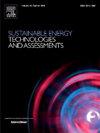CO2-assisted pyrolysis of plastic wastes: A review
IF 7.1
2区 工程技术
Q1 ENERGY & FUELS
Sustainable Energy Technologies and Assessments
Pub Date : 2025-01-25
DOI:10.1016/j.seta.2025.104209
引用次数: 0
Abstract
CO2-assisted pyrolysis is an effective method widely used in the chemical conversion of different raw materials to value-added products. In particular, CO2-assisted plastic pyrolysis can not only produce various hydrocarbons but also reduce the environmental pollution of plastic wastes and effectively reduce the emission of greenhouse gases. This technology has great significance for the treatment of urban plastic wastes. Herein, the latest progress in the pyrolysis of plastic wastes in the presence of CO2 is reviewed. Compared with typical pyrolysis in an inert environment (such as N2 or Ar), it is found that CO2 can change the type and yield of gas products, effectively inhibit the generation of benzene derivatives and polycyclic aromatic hydrocarbons (PAHs), and greatly prevent the reduction of catalyst activity. The conditions and catalysts required for CO2-assisted pyrolysis of different plastic wastes should be selected according to the requirements of desired products. Combined with pyrolysis kinetics, the proposed mechanisms of CO2-assisted plastic pyrolysis are introduced. Finally, the main issues of the current researches and the future development trend on CO2-assisted catalytic pyrolysis are discussed.
求助全文
约1分钟内获得全文
求助全文
来源期刊

Sustainable Energy Technologies and Assessments
Energy-Renewable Energy, Sustainability and the Environment
CiteScore
12.70
自引率
12.50%
发文量
1091
期刊介绍:
Encouraging a transition to a sustainable energy future is imperative for our world. Technologies that enable this shift in various sectors like transportation, heating, and power systems are of utmost importance. Sustainable Energy Technologies and Assessments welcomes papers focusing on a range of aspects and levels of technological advancements in energy generation and utilization. The aim is to reduce the negative environmental impact associated with energy production and consumption, spanning from laboratory experiments to real-world applications in the commercial sector.
 求助内容:
求助内容: 应助结果提醒方式:
应助结果提醒方式:


